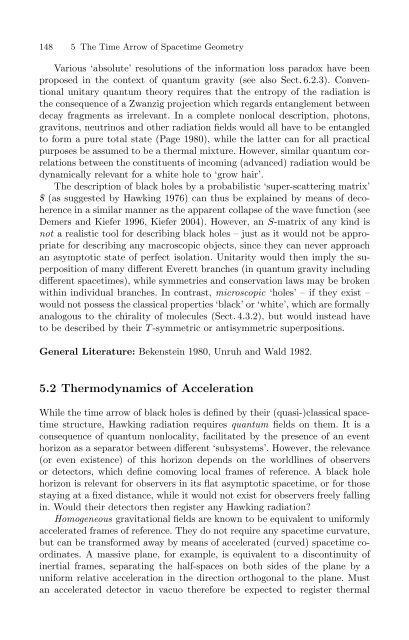The Physical Basis of The Direction of Time (The Frontiers ...
The Physical Basis of The Direction of Time (The Frontiers ...
The Physical Basis of The Direction of Time (The Frontiers ...
You also want an ePaper? Increase the reach of your titles
YUMPU automatically turns print PDFs into web optimized ePapers that Google loves.
148 5 <strong>The</strong> <strong>Time</strong> Arrow <strong>of</strong> Spacetime Geometry<br />
Various ‘absolute’ resolutions <strong>of</strong> the information loss paradox have been<br />
proposed in the context <strong>of</strong> quantum gravity (see also Sect. 6.2.3). Conventional<br />
unitary quantum theory requires that the entropy <strong>of</strong> the radiation is<br />
the consequence <strong>of</strong> a Zwanzig projection which regards entanglement between<br />
decay fragments as irrelevant. In a complete nonlocal description, photons,<br />
gravitons, neutrinos and other radiation fields would all have to be entangled<br />
to form a pure total state (Page 1980), while the latter can for all practical<br />
purposes be assumed to be a thermal mixture. However, similar quantum correlations<br />
between the constituents <strong>of</strong> incoming (advanced) radiation would be<br />
dynamically relevant for a white hole to ‘grow hair’.<br />
<strong>The</strong> description <strong>of</strong> black holes by a probabilistic ‘super-scattering matrix’<br />
$ (as suggested by Hawking 1976) can thus be explained by means <strong>of</strong> decoherence<br />
in a similar manner as the apparent collapse <strong>of</strong> the wave function (see<br />
Demers and Kiefer 1996, Kiefer 2004). However, an S-matrix <strong>of</strong> any kind is<br />
not a realistic tool for describing black holes – just as it would not be appropriate<br />
for describing any macroscopic objects, since they can never approach<br />
an asymptotic state <strong>of</strong> perfect isolation. Unitarity would then imply the superposition<br />
<strong>of</strong> many different Everett branches (in quantum gravity including<br />
different spacetimes), while symmetries and conservation laws may be broken<br />
within individual branches. In contrast, microscopic ‘holes’ – if they exist –<br />
would not possess the classical properties ‘black’ or ‘white’, which are formally<br />
analogous to the chirality <strong>of</strong> molecules (Sect. 4.3.2), but would instead have<br />
to be described by their T -symmetric or antisymmetric superpositions.<br />
General Literature: Bekenstein 1980, Unruh and Wald 1982.<br />
5.2 <strong>The</strong>rmodynamics <strong>of</strong> Acceleration<br />
While the time arrow <strong>of</strong> black holes is defined by their (quasi-)classical spacetime<br />
structure, Hawking radiation requires quantum fields on them. It is a<br />
consequence <strong>of</strong> quantum nonlocality, facilitated by the presence <strong>of</strong> an event<br />
horizon as a separator between different ‘subsystems’. However, the relevance<br />
(or even existence) <strong>of</strong> this horizon depends on the worldlines <strong>of</strong> observers<br />
or detectors, which define comoving local frames <strong>of</strong> reference. A black hole<br />
horizon is relevant for observers in its flat asymptotic spacetime, or for those<br />
staying at a fixed distance, while it would not exist for observers freely falling<br />
in. Would their detectors then register any Hawking radiation?<br />
Homogeneous gravitational fields are known to be equivalent to uniformly<br />
accelerated frames <strong>of</strong> reference. <strong>The</strong>y do not require any spacetime curvature,<br />
but can be transformed away by means <strong>of</strong> accelerated (curved) spacetime coordinates.<br />
A massive plane, for example, is equivalent to a discontinuity <strong>of</strong><br />
inertial frames, separating the half-spaces on both sides <strong>of</strong> the plane by a<br />
uniform relative acceleration in the direction orthogonal to the plane. Must<br />
an accelerated detector in vacuo therefore be expected to register thermal



![arXiv:1001.0993v1 [hep-ph] 6 Jan 2010](https://img.yumpu.com/51282177/1/190x245/arxiv10010993v1-hep-ph-6-jan-2010.jpg?quality=85)


![arXiv:1008.3907v2 [astro-ph.CO] 1 Nov 2011](https://img.yumpu.com/48909562/1/190x245/arxiv10083907v2-astro-phco-1-nov-2011.jpg?quality=85)








![arXiv:1002.4928v1 [gr-qc] 26 Feb 2010](https://img.yumpu.com/41209516/1/190x245/arxiv10024928v1-gr-qc-26-feb-2010.jpg?quality=85)
![arXiv:1206.2653v1 [astro-ph.CO] 12 Jun 2012](https://img.yumpu.com/39510078/1/190x245/arxiv12062653v1-astro-phco-12-jun-2012.jpg?quality=85)
